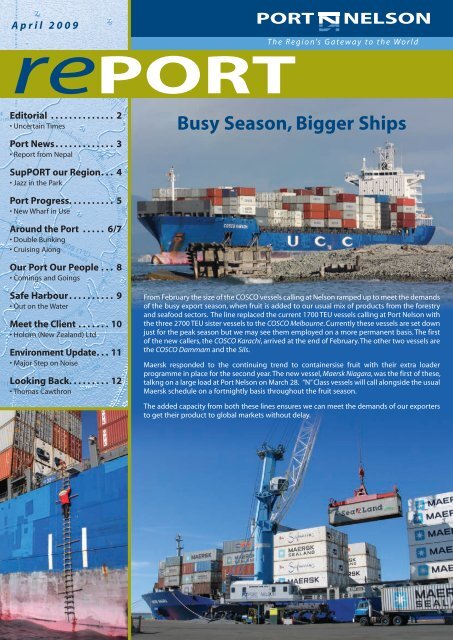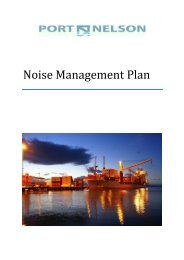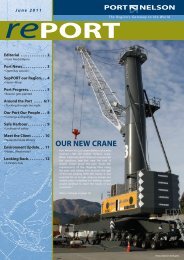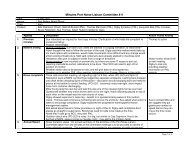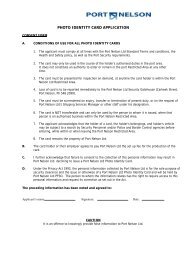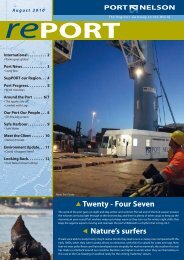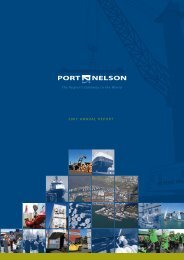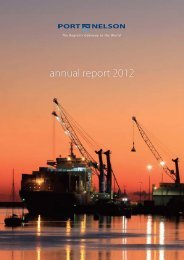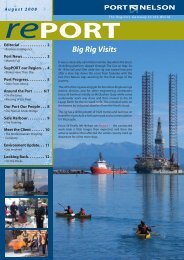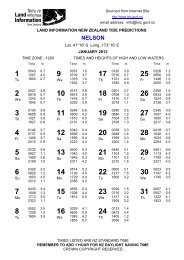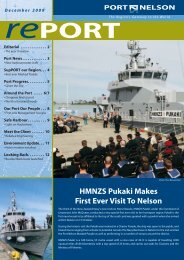April 2009 (pdf) - Port Nelson
April 2009 (pdf) - Port Nelson
April 2009 (pdf) - Port Nelson
Create successful ePaper yourself
Turn your PDF publications into a flip-book with our unique Google optimized e-Paper software.
<strong>April</strong> <strong>2009</strong><br />
rePORT<br />
Editorial . . . . . . . . . . . . . . 2<br />
• Uncertain Times<br />
<strong>Port</strong> News . . . . . . . . . . . . . 3<br />
• Report from Nepal<br />
SupPORT our Region . . . 4<br />
• Jazz in the Park<br />
<strong>Port</strong> Progress . . . . . . . . . . 5<br />
• New Wharf in Use<br />
Around the <strong>Port</strong> . . . . . 6/7<br />
• Double Bunking<br />
• Cruising Along<br />
Our <strong>Port</strong> Our People . . . 8<br />
• Comings and Goings<br />
Safe Harbour . . . . . . . . . . 9<br />
• Out on the Water<br />
Meet the Client . . . . . . . 10<br />
• Holcim (New Zealand) Ltd<br />
Environment Update . . .11<br />
• Major Step on Noise<br />
Looking Back . . . . . . . . . 12<br />
• Thomas Cawthron<br />
Busy Season, Bigger Ships<br />
From February the size of the COSCO vessels calling at <strong>Nelson</strong> ramped up to meet the demands<br />
of the busy export season, when fruit is added to our usual mix of products from the forestry<br />
and seafood sectors. The line replaced the current 1700 TEU vessels calling at <strong>Port</strong> <strong>Nelson</strong> with<br />
the three 2700 TEU sister vessels to the COSCO Melbourne. Currently these vessels are set down<br />
just for the peak season but we may see them employed on a more permanent basis. The first<br />
of the new callers, the COSCO Karachi, arrived at the end of February. The other two vessels are<br />
the COSCO Dammam and the Sils.<br />
Maersk responded to the continuing trend to containersise fruit with their extra loader<br />
programme in place for the second year. The new vessel, Maersk Niagara, was the first of these,<br />
talkng on a large load at <strong>Port</strong> <strong>Nelson</strong> on March 28. “N” Class vessels will call alongside the usual<br />
Maersk schedule on a fortnightly basis throughout the fruit season.<br />
The added capacity from both these lines ensures we can meet the demands of our exporters<br />
to get their product to global markets without delay.
<strong>Port</strong> <strong>Nelson</strong> Limited report. <strong>April</strong> <strong>2009</strong>. Page 2<br />
editorial<br />
Uncertain Times<br />
We head into another fruit season at a time of great uncertainty across many<br />
businesses, including a large number of our customers, whether they be<br />
exporters, importers or shipping lines.<br />
From a drop off in consumer demand for a myriad of products, through to<br />
plummeting sea freight rates, each of these parties are finding life tougher by<br />
the day. That is being reflected already in many ports where cargo volumes<br />
are falling. Countries such as China, Hong Kong and Singapore, which have<br />
experienced ongoing volume growth for many years have now started seeing<br />
a significant fall in figures for cargo handled, with little suggestion that pattern<br />
is likely to change in the near future.<br />
Closer to home a number of New Zealand ports are also starting to report a<br />
drop in volumes. In <strong>Nelson</strong> we have not been impacted too much in that area<br />
to date, but it is naive to expect this region will be exempt from the effect of<br />
these global issues as the situation evolves.<br />
From a <strong>Port</strong> <strong>Nelson</strong> Limited perspective it is clear that all of us within the<br />
company have an obligation to look at our own areas of operation and see<br />
what possible further efficiencies we can identify and where we can possibly<br />
assist our customers during these difficult times.<br />
Everything that we are seeing in the news indicates that this is not a ‘short<br />
term’ issue that will be over in a matter of months and the ramifications of the<br />
current financial recession may well be felt for a prolonged period of time.<br />
During such difficult times it is important that importers, exporters and service<br />
providers work together wherever possible to try and assist each other to<br />
weather the storm and we look forward to playing our part in that process<br />
where we can.<br />
We are fortunate in this region<br />
to be exporting products that<br />
will still, even if to a lesser<br />
extent, be in demand globally,<br />
and to have loyal markets built<br />
on many years of quality supply<br />
and service.<br />
Martin Byrne<br />
Chief Executive<br />
<strong>Port</strong> <strong>Nelson</strong> Limited<br />
<strong>Port</strong> <strong>Nelson</strong> Limited • 10 Low Street, <strong>Port</strong> <strong>Nelson</strong> • PO Box 844, <strong>Nelson</strong>, New Zealand<br />
Tel +64 3 548 2099 • Fax +64 3 546 9015 • www.portnelson.co.nz<br />
Re<strong>Port</strong> <strong>Nelson</strong> is a triennial publication produced for <strong>Port</strong> <strong>Nelson</strong> Limited by:<br />
• <strong>Nelson</strong> Media Agency - www.nelsonmedia.co.nz • SeeReed Visual Communication - www.seereed.co.nz<br />
Photography: Troy Dando, Roy Skucek and Jacquetta Bell<br />
Investment in<br />
Unimar Ltd<br />
We announced in the New Year that we<br />
have made a 25% investment in Unimar<br />
Limited, a <strong>Nelson</strong> based marine service<br />
company, that was formerly Nalder<br />
and Biddle. The company has grown<br />
considerably since its formation in 2004<br />
and is establishing a strong presence in<br />
the oil industry. It was the South Island<br />
service provider for the Maari well head<br />
float-off project earlier this year, which<br />
saw the heavy transport vessel Blue Marlin<br />
demobilised at <strong>Port</strong> <strong>Nelson</strong> before leaving<br />
New Zealand.<br />
This is a strategically important investment<br />
that will help to establish <strong>Port</strong> <strong>Nelson</strong><br />
as an alternative service centre for the<br />
offshore oil industry. It will assist with the<br />
economic growth of the <strong>Nelson</strong> region,<br />
improved utilisation of port infrastructure<br />
and enhanced returns to our shareholders,<br />
the two local councils.<br />
Unimar owns the Calwell Slipway at <strong>Port</strong><br />
<strong>Nelson</strong>, Marine and Industrial Stainless and<br />
Maritime Services.<br />
The sort of vessel we want to see more of: the semisubmersible<br />
Heavylift Falcon, that called here briefly in<br />
December, en route to Admiralty Bay to pick up the oil<br />
rig Ensco 056 for a trip to Asia
<strong>Port</strong> <strong>Nelson</strong> Limited report. <strong>April</strong> <strong>2009</strong>. Page 3<br />
Boost for Seafarers’ Mission<br />
<strong>Port</strong> <strong>Nelson</strong>’s Seafarers’ Mission has a reputation to<br />
maintain as the best in New Zealand and one of the<br />
busiest, so a steady income is a must. The mission trust<br />
had a major boost at the end of last year when PNL<br />
Chief Executive Martin Byrne handed over a cheque for<br />
$12,000 dollars, the proceeds of the November <strong>Nelson</strong><br />
<strong>Port</strong> and Transport Industry Charity Golf Tournament.<br />
There are plenty of ways the money could be spent,<br />
including carpet and tables to complete the upgrade of the<br />
centre, but manager Milo Coldren has other plans.<br />
“We’re putting this cheque straight in the bank,” he said.<br />
“We are very grateful for the generosity and support we<br />
have from the port company – they’ve got the Seafarers’<br />
Mission as the charity for next year’s tournament as well,<br />
which will give us a tidy capital sum that we will keep<br />
intact while using the interest for our everyday running<br />
costs.”<br />
Martin Byrne, Dean Charles Tyrrell, Milo Coldren and his admin assistant Rebekah<br />
Smith and Charles Hufflett from the Seafarers' Trust.<br />
Forklift Honour Guard<br />
A very unusual site in the Container Yard on March 18,<br />
with the drive past of Johnny Pav (Ivan Pavlinic), who<br />
had worked in the stevedoring division for just over seven<br />
years as a casual, then as a part-timer from 2006.<br />
Container Operations Supervisor Mark Smith shepherded<br />
the forklifts (that been working just minutes before) into<br />
two lines and Financial Accountant Mason Robinson<br />
played the Last Post in a moving tribute to a valued<br />
workmate.<br />
Martin, decorated for a colour festival, with local school children.<br />
Report from Nepal<br />
CEO Martin Byrne is just back from a leadership and<br />
development course that was a long way from the<br />
usual meeting rooms and white boards - literally.<br />
The course, offered by Kiwi run company Second Base,<br />
was held in Nepal, which put a whole new angle on the<br />
term ‘taking participants outside their comfort zones’.<br />
“The focus of the course was very much around<br />
values-based leadership. There was the traditional<br />
classroom environment type workshopping, but we<br />
also spent five days in Chitwan province in a small<br />
village, working on improvements to a school for<br />
disabled kids while living with local families and<br />
sharing their conditions,” Martin says. “This meant<br />
using outdoor squat toilets, making the most of the<br />
power when it was on for two four hour bursts a day ,<br />
and eating twice daily meals of dhal bhat - rice, lentils<br />
and curried vegetables.”<br />
The six course members shook this experience down<br />
in further workshop sessions in Pokhara and then did<br />
a four day trek on the Annapurna loop. Martin says the<br />
course was a 'life-changer' from a personal perspective:<br />
“When you’re put into conditions you’re not used to it’s<br />
quite a learning experience to see how you react,” he said.<br />
“There was also a strong team building aspect.”<br />
Overall he expects the course to have long<br />
term impacts on areas such as self-awareness,<br />
effectiveness, motivation and the ability to empower<br />
and lead effective teams.<br />
Navigation Chart<br />
An old harbour chart was found rolled up, water stained<br />
and barely legible during a recent workshop office clean<br />
out. It was on a direct trajectory to the bin when Workshop<br />
Supervisor Craig Terris gave it a closer look and found it<br />
was an original ink on paper and fabric chart of <strong>Nelson</strong><br />
Harbour from 1882. The chart, prepared by Captain<br />
Johnson, is an update of the 1850 Stokes chart. Craig<br />
googled ‘document repair’ and<br />
sent it off to Marion Mehrtens,<br />
a Wellington document conservator.<br />
Framed by Dickson<br />
Marine, using timber from the<br />
recent Main Wharf upgrade, it is<br />
now looking very handsome on<br />
the boardroom wall.<br />
Craig Terris and Murray McGuire admire<br />
the chart.<br />
port news
supPORTing our region<br />
We picked up a new sponsorship this year, in association with the Woollaston Jazzfest, which keeps locals and visitors<br />
entertained over four days in the early New Year. We sponsored seven <strong>Port</strong> <strong>Nelson</strong> Jazz in the Park sessions that gave thousands<br />
of people a free night out at a varied range of concerts from Takaka’s Village Green to <strong>Nelson</strong>’s Fairfield Park.<br />
Rowing On<br />
PNL has re-confirmed its sponsorship commitment to the<br />
<strong>Port</strong> <strong>Nelson</strong> Golden Edge <strong>Nelson</strong> Rowing Club on the back of<br />
their continued high performance at national events and their<br />
development of school kids into the sport.<br />
At the Banklink New Zealand rowing championships at Lake<br />
Ruataniwha in February racing was compressed to one day,<br />
but our teams held their nerve. The first gold of the day went<br />
to the women's senior eight who won by two boat lengths<br />
ahead of an Auckland team. With no time to celebrate, four of<br />
the rowers were back on the water for the under-19 coxed four,<br />
gaining the third place and going on to win the final. Overall<br />
the club took five gold medals, three silver and two bronze.<br />
Eleven rowers from the squad went looking for further<br />
honours at the Maadi Cup in early <strong>April</strong>.<br />
Blokes' Day Out<br />
Jazz in the Park<br />
Our support for the entry level triathlons, the <strong>Port</strong> <strong>Nelson</strong><br />
Blokes' Day Out and the Taylors <strong>Nelson</strong> Women’s Tri continued<br />
this year, with the kids also encouraged to take part in the<br />
Kauri Kids Aquathon. The event was run in perfect weather<br />
on March 29, and won by Nigel Burgess in a new record time<br />
of 42min 17sec. From the ‘home team’ Cargo Operations<br />
Manager Phil Francois and Business Analyst Hugh Stark<br />
did particularly well to win the walking section of the NBS<br />
Corporate Challenge.<br />
Fun at the Library<br />
‘We have seen our daughter’s reading improve, and with it<br />
her confidence.’<br />
‘The whole family has enjoyed our shared reading time and<br />
visits to the library.’<br />
Just some of the comments from parents about the<br />
Superheroes Summer Reading Programme at the library,<br />
sponsored by <strong>Port</strong> <strong>Nelson</strong>. One hundred 5 to12 year olds took<br />
part, doing some reading every day and making regular visits<br />
to the library to talk about their reading and to pick up a little<br />
surprise as a reward. After the holidays the children received<br />
a certificate, medallion and a book to keep. Another 30 preschoolers<br />
followed a simplified programme that wrapped up<br />
with a finale party at the library.<br />
Garin Bags It<br />
The Girl’s Soccer First XI at Garin College will be cutting a dash<br />
with new sports bags to go with their tops and sports strips.<br />
Twenty numbered and monogrammed bags in the school<br />
colours were bought with funding from <strong>Port</strong> <strong>Nelson</strong>. Garin<br />
Sports Director, Albie Evans says they chose bags as something<br />
many students could benefit from each year. From left are<br />
Sanchia Paterson and<br />
Maryann Cant. Maryann<br />
has subsequently gone<br />
on to be selected for the<br />
Mainland Under 16 girls<br />
representative team.<br />
Congratulations Maryann.
Main Wharf South Infill<br />
A wharf is more than just the place you tie up a vessel – the<br />
area alongside for storage and cargo movement is just as<br />
vital for a speedy ship turnaround. For this reason we are<br />
embarking on the consent process to infill the area behind<br />
Main Wharf South. Brunt Quay will remain the preferred<br />
container berth but the development will lessen truck and<br />
forklift trips, improve crane efficiency and enhance safety.<br />
The expected cost of the development is in the vicinity of<br />
$3million, with the construction period taking 6-9 months.<br />
Cawthron is doing a report on the environmental impacts,<br />
but these are expected to be minimal, with the loss<br />
of seabed offset by the habitat provided by the new<br />
structure.<br />
We are consulting with Iwi, environment groups and<br />
residents and also seeking their views on a public amenity<br />
in the harbour area as part of the project. This could<br />
be a port education centre, a jetty at the lighthouse or<br />
some other facility that may come up as a result of the<br />
consultation.<br />
Supersize Shopping<br />
It’s dirty work but someone’s got to do it…we recently sent<br />
Andy Farmer from QuayPack and Grant Cottle from the<br />
Workshop to Aussie to have a look at new forklifts. When<br />
you’re spending over a million dollars it pays to get it right.<br />
The plans are for a 32 tonne Omega 36D, primarily for<br />
unloading timber packs into sheds, and a Hyster 18.00XMS for<br />
QuayPack. Unfortunately the recent drop in the NZ exchange<br />
rate has boosted the purchase price. The two new machines<br />
are expected to arrive mid-year.<br />
New Wharf in Use<br />
<strong>Port</strong> <strong>Nelson</strong> Limited report. <strong>April</strong> <strong>2009</strong>. Page 5<br />
The newly strengthened Main Wharf North has been busy recovering the $3.4 million cost of the upgrade, with ships<br />
berthed at this wharf more often as we enter our busy season. The wharf is proving itself for Tasman Bay Stevedores<br />
with both cranes now able to be worked, and more room for storage and hatch cover placement. Overall there’s less<br />
vehicle movement, we don’t have to shift the vessel along the berth during loading and we’re getting a faster vessel<br />
turnaround.<br />
The COSCO vessel Sils made good use of the enhanced MWN facility in March.<br />
More Washing Up<br />
There has been a noticeable increase in<br />
containers needing a wash, especially dry<br />
boxes. This is driven by demand for top grade<br />
units for wine and dairy product loadings,<br />
along with more ‘dirty’ import cargoes such<br />
as fertiliser, palm kernel and salmon food<br />
being shipped into <strong>Nelson</strong> in containers. This<br />
means our new wash pad, completed by<br />
contractors HEB Structures, is getting plenty<br />
of use. The wooden and concrete blocks have<br />
been replaced with a solid concrete surface<br />
that is easier to clean, an added biosecurity<br />
advantage. Forklift drivers say the new wash<br />
bay is much easier to work, with the added spin<br />
off of less stress on the hi-stacker spreaders.<br />
Forklifts Go Hi-Tech<br />
New Year is when <strong>Nelson</strong> Pine Industries has its<br />
annual maintenance shutdown, which provided<br />
us with a quiet time to implement the JADE<br />
warehousing systems at QuayPack. Supervisor,<br />
Andy Farmer reports the change has gone<br />
extremely well: “We now scan all product as it<br />
comes in by truck,” he explains. “Every pack is<br />
given a date, location and is assigned a vessel,<br />
so there’s no lost time in hunting for product.”<br />
All credit to the IT guys with their behind the<br />
scenes know-how and to the Quay Pack team<br />
for their enthusiastic upskilling.<br />
Paul Stent uses the long-range scanner mounted on his<br />
forklift to read the code on stacked MDF packs.<br />
port progress
around the port...<br />
<strong>Port</strong> <strong>Nelson</strong> Limited report. <strong>April</strong> <strong>2009</strong>. Page 6<br />
It was a very close fit at the Main Wharf in late February when the bulk carrier Santiago<br />
Basin struck rudder problems at the same time as the container vessel Papuan Chief<br />
had a break down. Both ships were tied up unexpectedly for five days while repairs<br />
were carried out, so it was fortunate we had the wharf capacity to meet this need.<br />
Yachting calls<br />
There were several visits from ‘super-yachts’ over the summer,<br />
and even a rumour that Bob Dylan was holidaying on the<br />
52m ketch Tamsen. If the bard had been on board he’d have<br />
been able to chose between 11 staterooms, 13 bathrooms<br />
and a spa; somewhat more luxurious than the relatively<br />
modest Arcadia (pictured). Described by her skipper as a ‘big<br />
little superyacht’ the 36m Dutch built cruiser was tidying<br />
up in <strong>Nelson</strong> after the trans-Tasman trip, before visiting the<br />
Abel Tasman coastline.<br />
Home for Christmas<br />
The fishing berths were full for the festive season as crew<br />
took shore leave. There has been some bad news from this<br />
sector, with Sealord shedding jobs in the move to processing<br />
fish at sea, as the distance to fishing grounds dictates, backed<br />
up with increased on-board capability.<br />
Double Bunking<br />
▲<br />
HMNZS Resolution Visit<br />
HMNZS Resolution, the<br />
navy’s hydrographic ship,<br />
was in <strong>Nelson</strong> over the<br />
weekend of March 21.<br />
Originally the USNS<br />
Tenacious, she was<br />
used to track Soviet<br />
submarines, before being<br />
bought by the Royal New<br />
Zealand Navy in 1997.<br />
The Resolution now does<br />
survey work around the<br />
coast, which fits with her<br />
being named after the<br />
ship used by Captain Cook<br />
on this second and third<br />
voyages.<br />
The primary purpose of the <strong>Port</strong> <strong>Nelson</strong> call was to give crew<br />
a rest and recreation break during patrol operations.
Maersk City<br />
The annual influx of containers boosted the height of the<br />
Container Yard skyline from early in the year. There was a<br />
huge 715 container discharge from the Francoise Gilot in late<br />
January, including 400 hi-cube reefers for pipfruit loading as<br />
well as dry/general boxes.<br />
Cruising Along<br />
It was a light season for us as far as cruise ships go, starting with the Australian expedition ship<br />
the Orion, described as more a mega-yacht than cruise ship in port for two day calls at the end of<br />
November. The 95 passengers were greeted by WearableArts models and had the choice of shore<br />
excursions around the region or shopping in the city. The Orion sailed from <strong>Nelson</strong> to Abel Tasman’s<br />
Onetahuti Beach, for kayaking and exploring the park coastline by zodiac. It’s a little different from<br />
tramping the Abel Tasman – passengers go home to staterooms that feature internet access, flatscreen<br />
TVs, and marble bathrooms. Other on board amenities include a health spa with gymnasium,<br />
sauna and sun deck jacuzzi.<br />
<strong>Port</strong> <strong>Nelson</strong> Limited report. <strong>April</strong> <strong>2009</strong>. Page 7<br />
Kiwi Pride<br />
MSC Kiwi had been a regular visitor but was then taken off<br />
the <strong>Nelson</strong> run, with her New Zealand calls only at North<br />
Island ports. However the Kiwi is now back on the MSC<br />
Butterfly Service, which comes up the East Coast calling at<br />
<strong>Port</strong> Chalmers, Lyttelton and Wellington, with <strong>Nelson</strong> the last<br />
stop before crossing the Tasman to Sydney and MSC services<br />
to Asia, the Middle East and Europe.<br />
▲<br />
Fruity Options<br />
The busy fruit season is upon us, with growers reporting a<br />
good season. However, there’s a wait and see aspect on what<br />
returns they will get in the depressed northern hemisphere<br />
markets. Two reefer vessels called in March, and another three<br />
are expected between now and the end of June.<br />
The cruise ship Clipper Odyssey’s visit on February 13 ended the cruise ship calendar for the year, and though she only made the<br />
one visit, there are already another three visits booked for the end of the year. <strong>Nelson</strong> Tasman Tourism and <strong>Port</strong> <strong>Nelson</strong> Limited<br />
continue to actively promote the port and region to niche cruise ships.<br />
...and beyond
our port our people<br />
New Infrastructure<br />
Manager<br />
Matt McDonald, a <strong>Nelson</strong>ian and a Civil Engineering<br />
graduate from the University of Canterbury, joined the<br />
port company at the end of last year, taking over from<br />
Dick Carter on management of the environmental<br />
aspects of the port operation, and the maintenance<br />
and development of the port infrastructure.<br />
Matt has specialised in coastal and environmental<br />
engineering, with experience on large hydro projects<br />
and most recently on a Scottish water project. Matt,<br />
Michele and Benjamin (10 months) are enjoying<br />
exploring the region and spending time with family<br />
and friends.<br />
35 Years<br />
Ian with this workmates at the 25 year celebration.<br />
In early December <strong>Port</strong> Services Worker Ian Inwood<br />
celebrated his 35 years with the port, at a lunchtime<br />
barbeque. The Inwood association with the port goes<br />
back even further, to Ian and his brother Peter’s father,<br />
making this a remarkable contribution from the one<br />
family. The company presented Ian with a new set of<br />
bowls to mark the occasion and the <strong>Nelson</strong> Mail picked<br />
up on the story and ran a photo of Ian with the cranes<br />
that he has helped care for over the last decade.<br />
Congratulations too to Tom Stewart who reached his 25 year milestone,<br />
also in December.<br />
<strong>Port</strong> <strong>Nelson</strong> Limited report. <strong>April</strong> <strong>2009</strong>. Page 8<br />
Comings and Goings<br />
Jon Bennett is our new Business Systems Analyst, coming to us<br />
from NMIT where he has worked for the past four years after<br />
graduating with his Information Technology degree. Jon and<br />
Sylvie and their four children emigrated to New Zealand in 2002<br />
and have a lifestyle block in Dovedale.<br />
Elaine Carter is full time now in the Gatehouse while Joanne Long<br />
is on parental leave. Elaine has worked with us off and on since<br />
2004, so brings a lot of experience to the role.<br />
Johan Verhage is a fully qualified electrician in the Netherlands,<br />
and as our Trainee Electrician will get the two years practical<br />
experience he needs to register in New Zealand. He and his <strong>Nelson</strong><br />
wife Anna have settled in Richmond.<br />
Steve Ehau is the latest addition to QuayPack’s permanent staff.<br />
His varied work history ranges from the armed forces to a stint as<br />
a youth worker with the New Hub.<br />
Chris Growcott has joined our Logistics team, bringing the<br />
expertise gained as Container Dispatch Co-ordinator with Toll<br />
Tranzlink for the past four years.<br />
Graeme Kinzett adds his extensive forklift driving experience to<br />
our Logistics team. Off work Graeme enjoys flying and has his<br />
private pilot’s licence.<br />
Farewell to Frances<br />
Frances Woodhead, our Environmental Officer, is leaving us to live on<br />
the Isle of Tiree, population 750 and situated off the Scottish coast.<br />
‘It’s all in the name of love!’ said Frances. She plans to keep doing her<br />
art glass work and will keep the environmental connection alive with<br />
a 20 hour a week job for Tiree Rural Development as a Powerdown<br />
Officer. This role is one of 27 community positions created recently<br />
across Scotland to implement carbon reduction initiatives. On Tiree<br />
this means composting toilets, a zero emissions shower block for the<br />
tourists and electric cars for the locals.<br />
Frances brought great enthusiasm and professionalism to the<br />
environmental side of our operations, particularly as we worked<br />
through ISO certification and the <strong>Port</strong> Noise Variation. We wish her<br />
every happiness as she follows her heart to the long summer days<br />
of the very far north.<br />
Frances will be taking her<br />
glass kiln to Tiree.
Everything was real – except for the 100 metre flames. An oil<br />
fire drill on January 22 had the tanker Kakariki on fire, the fire<br />
service spraying water, the tanker spouting foam, everyone<br />
evacuated from the port area and the tugs all set to tow the<br />
Tasman Chief away from Brunt Quay if it became engulfed by<br />
flames. The Waimea 2 and the workboat were called out to<br />
assist in traffic management and to help evacuate the crews<br />
off the ships. It was a good effort by all and a very worthwhile<br />
exercise.<br />
Pilot Gavin Giblett briefs the assembled crew of the Tasman Chief on the<br />
emergency procedure…they were to get ready to evacuate via the pilot’s ladder.<br />
Just for Men<br />
Women’s health gets a lot of attention, and now PNL men<br />
will be getting their share of it, with the new initiative of a<br />
prostate health check being offered to our male staff. Our<br />
occupational health nurse canvassed support for the concept<br />
at the regular annual health checks last year, and gathered<br />
over sixty names from chaps who said they’d give it a go.<br />
So we followed up with some advice on the procedure (note<br />
it is just a blood test!) and the tests have been taken in<br />
batches of 12 every Tuesday over the last few weeks. Results<br />
go direct to the staff member’s GP, so confidentiality is assured.<br />
Keeping our team healthy is in everyone’s interests.<br />
Fire Drill<br />
Keeping Safe<br />
<strong>Port</strong> <strong>Nelson</strong> Limited report. <strong>April</strong> <strong>2009</strong>. Page 9<br />
Out on the Water<br />
The Waimea 2 has been extra busy over the holiday<br />
period, in between pilot jobs, taking on an active role<br />
on the water as the harbourmaster craft, representing<br />
the <strong>Nelson</strong> City Council.<br />
There has been a noticeable reduction in boats<br />
exceeding the 5 knot speed limit in the inner harbour,<br />
with patrols conducted randomly between Monaco in<br />
the south to Cape Soucis in the north. Public feedback<br />
has been positive, with many people saying they have<br />
noticed a marked improvement in behaviour when the<br />
Waimea 2 is on the water in her harbourmaster role.<br />
The fire service trains water on the hull of the Kakariki.<br />
Passed Again!<br />
We are thrilled with the news that we have flown through our<br />
latest ACC Workplace Safety Management Practices (WSMP)<br />
audit and maintained the highest level of accreditation. To get<br />
confirmation from an independent third party that our safety<br />
systems and practices meet the tertiary level audit standard<br />
recognises the efforts of our staff towards safety on site, and<br />
the added benefit of a discount on our ACC levies.<br />
The auditor visited us in late January for what is largely a<br />
paperwork exercise, looking for evidence and confirmation<br />
that we are meeting the standards of the WSMP programme.<br />
However, the auditor also looks for verification of safe systems<br />
in action, such as staff wearing safety clothing and clear<br />
marking of emergency exits.<br />
All staff can be very proud of the result, which reflects their<br />
ongoing commitment to safety in the workplace.<br />
We welcome any suggestions or information to make <strong>Port</strong> <strong>Nelson</strong> a safer working environment.<br />
If you have a name you would like added to our mailing list, please let us know.<br />
safe harbour
<strong>Port</strong> <strong>Nelson</strong> Limited report. <strong>April</strong> <strong>2009</strong>. Page 10<br />
meet the client<br />
Holcim (New Zealand) Ltd<br />
It’s the second ‘most used commodity’ in the world after water, and it’s delivered to our port every fortnight.<br />
The product is cement from Holcim (New Zealand) Ltd, a<br />
leading global supplier with New Zealand origins dating back<br />
to 1888. Holcim now supplies cement in bulk to ready-mix<br />
concrete and other customers using eight dedicated marine<br />
terminals at the ports of Auckland, Napier, Gisborne, New<br />
Plymouth, Wellington, Lyttelton, Dunedin and <strong>Nelson</strong>. Cement<br />
supplied to <strong>Nelson</strong> comes from Holcim’s Westport works, which<br />
have been operating virtually non-stop for the last fifty years.<br />
Tim Knight is the <strong>Nelson</strong> Depot Supervisor, and he and a<br />
tanker driver oversee the discharge of bulk cement from the<br />
two carriers, MV Milburn Carrier II and MV Westport to the 27m<br />
storage silo on Wakefield Quay, and thence around the Top of<br />
the South. The vessels visit <strong>Nelson</strong> every couple of weeks and<br />
can discharge pneumatically between 180 and 330 tonnes<br />
per hour, taking around 12 -14 hours to fill the 2800 tonne<br />
capacity silo. With both vessels making around 300 port calls<br />
each year, Tim says he really appreciates the work that goes on<br />
behind the scenes to make the berth available to the ships.<br />
“<strong>Port</strong> <strong>Nelson</strong> Ltd ties our ships up and provides services, so we<br />
have a very close relationship,” he says. “The location of our<br />
pipes means we are restricted to just one berth – so it’s a big<br />
task to fit our needs in with the rest of the shipping schedule.<br />
The port company has their own matrix to juggle and because<br />
of the nature of the business, things can change fast but we<br />
rarely have a delay and they keep us well notified.”<br />
Limestone is quarried at Cape Foulwind, processed into cement<br />
at the Westport Works, then trucked and stored in silos at the<br />
Westport wharf before being loaded on to the ships.<br />
Holcim Westport liaises with <strong>Port</strong> <strong>Nelson</strong>, and depending on<br />
the tides, the availability of the berth and the needs of other<br />
depots around the country, a schedule is worked out and Tim<br />
is notified. However, he says if there is a big job at another<br />
centre it might change the whole equation.<br />
Tim says Holcim does a fantastic job of forecasting and<br />
updating stocks everyday, and this ties into production. It also<br />
helps that concrete companies are good at giving Holcim<br />
notice of any big jobs they have coming up.<br />
Holcim and <strong>Port</strong> <strong>Nelson</strong> have a shared commitment to<br />
health and safety and environmental issues, and Tim says<br />
the company is great at keeping him informed about port<br />
activities.<br />
“As a contractor sited at the port we have monthly meetings<br />
with Cargo Operations and <strong>Port</strong> Security, stevedoring reps<br />
and others, and we are consulted about any issues that may<br />
affect our operations. For example, we were involved in an<br />
emergency plan for periphery services developed following<br />
the July 2008 storm that closed the port.”<br />
The Wakefield Quay cement silo had a makeover in 2002<br />
when Holcim New Zealand rebranded. The global brand logo<br />
of Swiss company Holderbank Cement, a stylised black H<br />
painted over a red C, replaced the previous Milburn signage. It<br />
is now one of the most visible brands on the <strong>Nelson</strong> cityscape,<br />
which is fitting, since cement from the silo has helped to build<br />
our city and our region.
Major Step on Noise<br />
In early March the city council adopted the recommendations of independent<br />
commissioners on the management of port noise. The commissioners<br />
accepted the <strong>Port</strong> Noise Variation to the <strong>Nelson</strong> Resource Management Plan,<br />
with <strong>Port</strong> <strong>Nelson</strong> Ltd responsible for minimising the amount of port noise at<br />
the source, providing acoustic insulation to qualifying houses, and offering to<br />
purchase the most affected houses. Noise insulation standards are defined for<br />
alterations and new homes in the affected areas. This is a major step forward<br />
in a process that began in 1994. However, the decision by Council is open to<br />
appeal to the Environment Court 30 days from its release in early March.<br />
We have now completed noise mitigation works for the first two Stage 1<br />
properties affected by port noise on Queens Road. The work has involved<br />
installing acoustic proof glass, re-lining and installation of ventilation systems.<br />
One of the two properties was bought by PNL at the request of the owner and<br />
now that the work is complete the property is back on the market.<br />
A free lunch?<br />
<strong>Port</strong> <strong>Nelson</strong> Limited report. <strong>April</strong> <strong>2009</strong>. Page 11<br />
Members of the Environmental Consultative Committee have<br />
been giving up their lunchtimes for many years now for the<br />
regular environmental meetings…looking for no reward<br />
other than a free lunch and an annual ride in a boat around<br />
the port! This year’s port tour included <strong>Nelson</strong> City Council<br />
Resource Management staff. The tour covered the slipway<br />
contaminant trap, the proposed infill behind Main Wharf<br />
South and storm water management.<br />
Introducing the Scrubber<br />
The new code of practice for methyl bromide fumigation that<br />
requires recapture of the fumigant is now in place, with new<br />
ducting, monitoring and scrubbing systems installed in Shed<br />
#3. The re-capture systems for containers and timber stacks<br />
operate until the concentration of methyl bromide is down<br />
to new levels set in the Air Plan. This season timber for export<br />
to Australia has been covered and fumigated in small blocks<br />
to allow the methyl bromide gas to be removed by the new<br />
Nordico Recovery system. <strong>Port</strong> <strong>Nelson</strong> is well ahead of the<br />
rest of the country on this issue and others are now following<br />
suite.<br />
A stack of timber being vented from under the covers in Shed #3. An added advantage<br />
of the new process is that much less methyl bromide is needed, compared with when<br />
the whole shed was filled.<br />
Environmental Management<br />
System Audit<br />
The impact of our operation on the local and the global<br />
environment came under scrutiny with the annual visit<br />
from the ISO 14001 auditor in early February. It was a<br />
pleasure to have the benefit of an outside eye looking<br />
at our system and bringing specialist knowledge of best<br />
practice in environmental management systems. The auditor<br />
commented that our system is shaping up well with high<br />
levels of staff awareness and progress towards targets.<br />
Mystery Maitai Pipes<br />
What do invasive marine organisms hate? The answer is<br />
fresh water, so it seems like a ‘no-brainer’ to divert some<br />
Maitai water into the marina to stop bio-fouling of boats.<br />
The suggestion came up at an Environmental Consultative<br />
Committee meeting, followed by a vague recollection that<br />
there were some pipes under the Akersten Street causeway<br />
that would do the job. <strong>Port</strong> Senior Engineering & Hydrographic<br />
Officer Murray McGuire couldn’t find the pipes on any plans<br />
and it was thought they may have silted up. But like many<br />
mysteries, the answer was actually quite obvious – at low tide<br />
the two 600mm pipes can be seen bubbling fresh water into<br />
the marina, just along from the curve in the road.<br />
A keen yachtie helped<br />
point them out, and<br />
he has even put in a<br />
‘backyard’ diversion<br />
system. <strong>Port</strong>, Council<br />
and Cawthron staff gave<br />
the pipes a once over<br />
and will now measure<br />
water flow and salinity<br />
levels to assess whether<br />
the river water inflow<br />
will have any effect on<br />
bio-fouling.<br />
Insulation work<br />
on a Queens Road<br />
property<br />
Re<strong>Port</strong> is Green<br />
In line with our environmental policies Re<strong>Port</strong> uses elemental<br />
chlorine free paper produced from sustainably managed forests.<br />
Re<strong>Port</strong> is printed with vegetable based inks.<br />
environment update
<strong>Port</strong> <strong>Nelson</strong> Limited report. <strong>April</strong> <strong>2009</strong>. Page 12<br />
looking back<br />
That’s how Thomas Cawthron<br />
(1833 -1915) was described<br />
by his biographer, David<br />
Miller. The name lives on<br />
with the Cawthron Institute,<br />
and most <strong>Nelson</strong>ians could<br />
probably tell you that<br />
Cawthron donated the<br />
Church Steps and the chains<br />
along Rocks Road. But it<br />
wasn’t until the end of last<br />
year that the <strong>Nelson</strong> Tasman<br />
Chamber of Commerce, as<br />
part of its 150th anniversary<br />
celebrations, made Thomas<br />
Cawthron an inaugural<br />
inductee of its Hall of Fame.<br />
It’s also not widely known<br />
that Cawthron’s business<br />
dealings were largely based<br />
around the port, and his first<br />
office was in a wrecked ship.<br />
Thomas Cawthron<br />
Businessman and Benefactor<br />
“<strong>Nelson</strong>'s most philanthropic citizen whose bountiful generosity has<br />
done so much for the welfare of its people.”<br />
Cawthron arrived in New<br />
Zealand with his parents in<br />
1849, but was soon lured<br />
over the Tasman to the goldfields. Returning a few years<br />
later he started out in business with a contract to dig the<br />
test drives for copper deposits on the Dun Mountain; going<br />
on to provide supplies for the copper-mine, and setting up<br />
office in the beached hulk of the Albion at <strong>Port</strong> <strong>Nelson</strong>. The<br />
business developed as a general merchant and Cawthron<br />
made the most of new opportunities: when steam ships<br />
brought an increased demand for coal, he got involved with<br />
the development of the Enner Glynn Coal Mine, and when<br />
gold was discovered in Golden Bay, he shipped miners' stores<br />
and equipment to the boom towns. Gold had a huge impact<br />
on <strong>Port</strong> <strong>Nelson</strong>, trebling inward cargo between 1860 and<br />
1865, and making the port attractive to regular calls from<br />
steam ships for the first time.<br />
Photo supplied by Cawthron Institute.<br />
Cawthron amassed shipping<br />
agencies, starting with the<br />
Panama Royal Mail Steamship<br />
Co in 1859, and by 1876,<br />
when the Union Steam Ship<br />
Company of New Zealand<br />
took over the New Zealand<br />
Steam Shipping Company, he<br />
had a monopoly of shipping<br />
agencies in <strong>Nelson</strong>, controlling<br />
practically the whole of the<br />
maritime shipping from the<br />
busy port.<br />
Cawthron’s ‘Midas Touch’<br />
carried over to his investments<br />
in shares and property and<br />
by the time he retired in<br />
the late eighties he had a<br />
considerable fortune. He had<br />
a reputation as a miser, but<br />
quietly gave money to many<br />
causes, and was influenced<br />
by his friends to make his<br />
bigger civic donations.<br />
These include the Church<br />
Steps, the chains and posts along Rocks Road, extensions to<br />
<strong>Nelson</strong> Hospital and nurses' home, a 1000ha reserve near Dun<br />
Mountain and the organ at the <strong>Nelson</strong> School of Music. Seven<br />
years after his death the Cawthron Institute was founded, and<br />
has done major research on soils, agriculture and biochemistry,<br />
while playing an important role in stimulating government<br />
scientific research.<br />
Today one of the Cawthron Institute’s strengths is marine<br />
research. Cawthron scientists carry out the surveys and<br />
reports that are used in support of <strong>Port</strong> <strong>Nelson</strong>’s consents<br />
for dredging work, and they make a valuable contribution to<br />
our Environment Committee on issues from water quality to<br />
marine invaders.<br />
Sources: Karen Stade, The Prow (local history website); Margareta Gee, Dictionary of NZ Biography 2007; and Theodore Rigg, Encyclopaedia of NZ, 1966.<br />
Image below Edwin Harris from The History of <strong>Port</strong> <strong>Nelson</strong>, Ruth Allan 1954.<br />
The Albion Wharf in the late 1870s.


